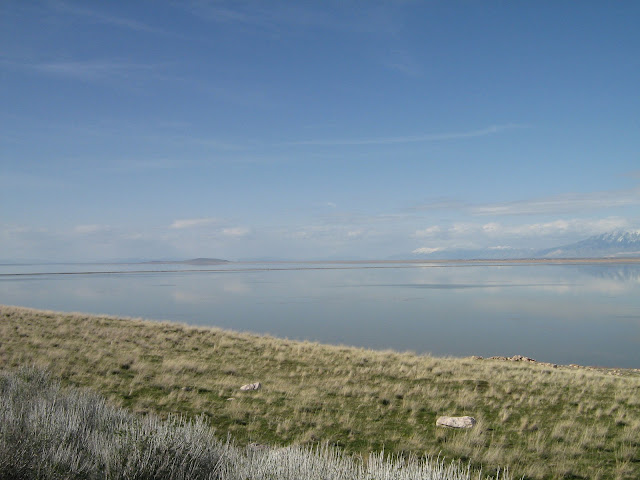 |
| Antelope Island is pretty even from a distance. |
 |
| It's not an antelope, but bison are pretty cool, too! |
 |
| A causeway lets you easily drive to the middle of the Great Salt Lake. |
 |
| The view from the Fielding Gar Ranch isn't bad, either. |
 This isn’t the first time on my blog that I’ve mentioned Antelope Island, a nature reserve surrounded by the Great Salt Lake. A few days ago, I stumbled on the stunning bird photography on this website, and that made me want to revisit my own photos of this one-of-a-kind area.
This isn’t the first time on my blog that I’ve mentioned Antelope Island, a nature reserve surrounded by the Great Salt Lake. A few days ago, I stumbled on the stunning bird photography on this website, and that made me want to revisit my own photos of this one-of-a-kind area.
This is what I wrote about it in a blog from 2011:
“The Great Salt Lake is the remnant of a prehistoric lake that spanned most of western Utah back in the day. Fed by three mineral-rich rivers (the Jordan, Weber, and Bear), the lake only loses water through evaporation, so the water gets saltier every year. The largest creatures that inhabit its cloudy waters are brine shrimp the size of fingernail clippings. These, coupled with vast amounts of brine flies, draw a host of birds. Avocets, black-and-white wading birds with orange shoulder and upturned bills, feed in the shallows while American coots, duck-like birds with black plumage and white bills, paddle around in the deeper areas. “Deeper” is a relative term— although the Great Salt Lake covers 1,700 square miles, on an average year it barely gets deeper than 30 feet.
 “The visitor center boasted a dizzying amount of information (Antelope Island contains rocks older than the bottom of the Grand Canyon, apparently), but my favorite part was a clip from a silent film shot on location on the island. Mostly a bloodbath of bison hunting and dramatic scenes of pioneers getting caught in quicksand, it contained such thought-provoking dialogue (written neatly in white Times font) such as “If Brigham Young, the Mormon leader, could get out west with all them wives, then I can sure ‘nough do it with my wagons!” We also visited a working cattle ranch with historical buildings that showed the history of the ranch from the first white settlers in the mid-1800s up until present day.”
“The visitor center boasted a dizzying amount of information (Antelope Island contains rocks older than the bottom of the Grand Canyon, apparently), but my favorite part was a clip from a silent film shot on location on the island. Mostly a bloodbath of bison hunting and dramatic scenes of pioneers getting caught in quicksand, it contained such thought-provoking dialogue (written neatly in white Times font) such as “If Brigham Young, the Mormon leader, could get out west with all them wives, then I can sure ‘nough do it with my wagons!” We also visited a working cattle ranch with historical buildings that showed the history of the ranch from the first white settlers in the mid-1800s up until present day.”
Why you should go: If you’re a history buff or a nature lover, this island has plenty to offer. It showcases an interesting slice of western history and is an essential resting place for migratory birds, not to mention a unique ecosystem and a stunning panorama.
 How to get there: Here are driving directions.
How to get there: Here are driving directions.
What to bring: Money— a day pass is $9 per car or $3 a person if you’re walking/cycling in. Bring sturdy clothes and shoes if you want to hike, and some sort of protection from the sun since there aren’t any trees. Pack a picnic lunch and lots of water. If you have a camera and a pair of binoculars, be sure to take them along too!
What else you need to know: If you’re not a hiker, there is still plenty to see; you can pull off the road in most places, have a picnic, and admire the scenery. Be sure to check out the visitor’s center and the ranch, which both help expand on the island’s past, both geologically and historically.

No comments:
Post a Comment